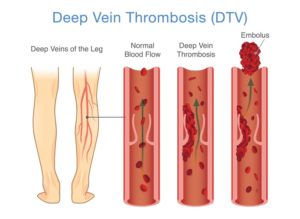 A blood clot in the leg – or deep vein thrombosis (DVT) – is a very serious health condition. If a clot in the leg dislodges, it can travel to other parts of the body, causing blockages and complications. Even if it stays in the leg, it can trigger symptoms. If left untreated, contribute to health problems.
A blood clot in the leg – or deep vein thrombosis (DVT) – is a very serious health condition. If a clot in the leg dislodges, it can travel to other parts of the body, causing blockages and complications. Even if it stays in the leg, it can trigger symptoms. If left untreated, contribute to health problems.
An estimated 900,000 Americans become affected by DVT annually, and it’s estimated that up to 100,000 deaths may be a result of DVT.
Advertisement
By recognizing the early symptoms of DVT, you can prevent complications from arising. But first, it’s essential to have a better understanding of blood clots.
For starters, a blood clot often forms in the vein, responsible for returning blood to the heart. It is more common in deeper veins within the legs. Blood clots obstruct blood flow, which disrupts blood circulation and affects blood flow to and from the heart. Early signs of a blood clot are swelling, warmth, and pain.
Another complication resulting from DVT is known as thrombophlebitis – inflammation of the affected vein. Furthermore, if the clot dislodges and begins to travel around the body, it can lead to complications such as pulmonary embolism, where the clot lodges at the lungs. This disrupts the ability to breathe and can lead to death.
Symptoms that follow pain and swelling include skin discoloration; cramping that can worsen during the night, and cramping that makes moving the foot excruciating.
Risk factors for a blood clot in the leg include a family history of blood clotting, disease, or injury. For example, a blood clot may be a result of prolonged bed rest due to lack of circulation caused by inactivity. For this reason, a person who just underwent surgery is at a high risk for a blood clot.
Some lifestyle habits that may increase the risk of blood clots include being a smoker and being overweight.
Advertisement
If you suspect you have a blood clot in the leg, it’s essential that you seek medical attention immediately so that treatment can be administered and your risk of complications reduces. Treatment can vary depending on a person’s current health status but can range from the administration of blood thinners to more invasive treatments where doctors go in to remove the clot.
It’s advised that you exercise regularly to reduce your risk of leg blood clots as to improve circulation along with reducing your weight.
Also read:
- Healthy veins: Natural ways to avoid venous insufficiency
- Natural vasodilators: How to dilate blood vessels naturally and increase blood flow
- Essential oils for circulation: 10 best oils to improve blood circulation
